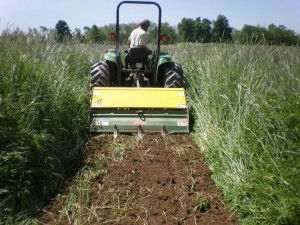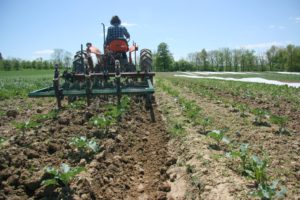The greatest challenge organic vegetable farmers confront every season is weed control. Cultural practices such as cover cropping, mulching, crop rotation, and balancing soil nutrients and biology are important tools for managing weed pressure, but most farmers working on a scale of more than one or two acres also control weeds through various forms of mechanical cultivation. There are innumerable types and forms of tractor mounted cultivators, from basket weeders mounted on the belly of cultivating tractors to tine weeders pulled on a three-point hitch. We have worked with numerous different mechanical cultivators on our farm and have found that no single tool is a silver bullet. We currently carry belly mounted sweeps on our cultivating tractor and a William’s tool system on the hitch.
Cultivators are essentially different types of hoes and hand weeders carried by a tractor, and we all have our favorite hand tools according to soil conditions, weeds species, and personal preference. It is no different with cultivators. The key point is how you use them. There are several cultivation strategies you can adapt, regardless of which particular tools you use on your farm, which will make your time spent more effective.
Do it early and often
The first strategy we employ to control weeds on our farm is using tillage and/or cultivators for stale seedbed preparation. The premise behind stale seedbed management is to encourage weeds to germinate and then kill them before a crop is ever planted. On our farm we either use a spading machine to do a final, shallow tillage pass immediately before we plant a bed, or we run through with the tine weeder on our Williams toolbar to wipe out the weeds before we plant. In some cases we will perform multiple stale seedbed cultivation passes before a crop is ever planted. This allows us to eliminate two or three generations of weeds before we even sow a single seed. Stale bedding is a fast, easy, and extremely effective weed control strategy.

It is always a good idea to cultivate crops as early as possible, stale seed bed preparation is the most extreme example. We like to cultivate crops as soon after germination or transplanting as possible as well. The best and most effective time for cultivating is before you can see any weeds. Weeds are the most vulnerable after their seeds have sprouted white threadlike roots but have yet to send their green leaves reaching skyward.
Last season we were training our apprentices cultivating tiny snap peas that had just germinated. It was an extremely dry April and there were no weeds to be seen among the baby peas. It was late in the day and, to our eyes, our efforts at cultivating the peas were more for practice than necessity. We headed back to the barn with only half of the pea beds done. It then proceeded to rain for the next four weeks. We were unable to cultivate the muddy peas again until just before we trellised them. There was a clear difference in weed pressure between the beds we had cultivated weeks before and those we had not. Even though we could not see it at cultivation time, we had killed approximately sixty percent of the weeds in those beds we had managed to cultivate.
We have found that in addition to cultivating early, it is best to cultivate as often as possible. We tell our apprentices that as long as you can still get over a crop with the tractor, you should cultivate it. We try to cultivate everything on our farm every week to ten days. It is important to be especially vigilant in the spring when the most weed seeds germinate. After the summer solstice weed germination dramatically decreases.
In late summer and early fall we might cultivate only once every two weeks. It seems that the seeds “know” that if they germinate too late in the season frost may kill them before they have a chance to produce their own viable seeds. It is also a good practice to get out and cultivate as soon after a rain as possible. Nothing increases weed germination like a good rain, and if you get out with the cultivator as soon as the ground is fit to work you can really set the weeds back and send your crops forward with minimal competition.
Play it fast and loose
Another key to effective cultivating is to get as close to your crops as possible with your cultivators. We like to get within two inches of our crops with aggressive tools like sweeps, and we often run our tine weeder as a blind cultivator right through the crop. As we become more familiar with our cultivators we use them more aggressively every year and have found that our crops have greatly benefitted. The old farmers’ saying is that, “If you’re not killing at least some of your crop, you’re not getting close enough,” and we have found it to be true. While it may be hard to watch your cultivators “rough up” your crops, they will be cleaner, healthier and easier to harvest as a result.

Along these same lines it is good practice to cultivate crops at the fastest speeds possible. We are always urging our apprentices to push the envelope and drive the cultivating tractor faster. Remember cultivators are just hoes and hand weeders, and like these hand tools, they will work better the quicker they are pulled through the soil. Somewhat surprisingly, it is also easier to drive the tractor straight and true at faster speeds with as little stopping to check on your progress as possible. Just like riding a bike, you tend to drive straighter and with more control as your speed increases.
Why worry about weeds?
Mechanical cultivation is the cornerstone of our farm’s weed management plan. We rely heavily on cover crops, mulch, rotation, and fallowing land as well, but still have found that active weed control methods are vital to the quality and quantity of our harvest. Fields clean of weeds are not only pleasing to the eye; they are easier to harvest, harbor less diseases, and use water and nutrients more efficiently. We have found that many different cultivating tools work well under different conditions, and our tools are constantly evolving and changing. How we use our tools is the constant in our weed management plan. We cultivate early, close, fast, and often. If you design your farm around your cultivation tools and follow these principles, you give yourself the best chance of winning the annual war with the weeds.

